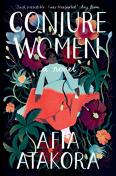
by Atakora Afia
Hardcover- $18.39
Click on the ORANGE Amazon Button for Book Description & Pricing Info
Overall rating:
How would you rate this book?
Member ratings
Conjure women: A Novel, Afia Atakora, author; Adenrele Ojo, narrator
The book is divided into five parts with descriptive chapter names that indicate the timeline and content. It travels in time from 1854 to 1929 and covers the lives of three women endeavoring to survive their own particular burdens, during troubling times that go back and forth between moments of struggle and moments of hope. The chapter names are Freedomtime, Slaverytime, Wartime, Surrender, The Ravaging, Promise, Exodus, In the Beginning, and Gilead. Several recur more than once as the novel goes back and forth in time to illustrate the struggle for independence and freedom experienced by both slaves and their masters.
The slaves were chattel, considered nothing more than workhorses by their owners. They were not taught to read so they learned nothing of the world outside of the place they worked. They were sold at will, and families were torn asunder capriciously with little thought for their feelings. They were physically, mentally and sexually abused. The punishments were meted out regardless of whether or not there was an offense. It was simply the will and whim of the slave owner that dictated treatment and lifestyles. No matter how you slice it, the situation was abominable.
The book centers around three women. Mae Belle is a healer and conjurer. Her daughter Roe has been taught the healing arts, the condition which protects her and allows her to remain with her mother. As the plight of the slave is highlighted, there is a hierarchy of superstitions that is apparent. When something does not go as planned, they become certain it is because someone has cursed them with a spell. It is Mae Belle who provides them with the solutions they need to counteract or initiate a spell. Roe and the daughter of Marse Charles, Varina, are the same age. They are friends, albeit with Varina calling the shots, since she is white and it is her father’s plantation. She does abuse and take advantage of Roe, at times, but when Roe has the opportunity to take charge of her friend, she returns that favor. When slavery ends, Roe engineers conditions to control her life and to maintain the stable community the slaves have created on Varina’s land.
After her mother, Mae Belle, passes away, Roe becomes responsible for birthing the babies and curing the ailments of the slaves with herbs and plants and medications she prepares. Roe largely sticks to using her knowledge without magic, as she is untrained in the art of conjuring. Superstition reigns until Bruh Abel comes to town to preach, and he ultimately sets up a congregation conducting baptisms and services. When a disease ravages the community, without rhyme or reason, taking young and old, he brings religion to the former slaves, and offers them hope and camaraderie as he comforts those who are ill and those whose children are dying. They no longer trust Roe as they once did. They suspect she might have cast a spell that is causing the illnesses afflicting them.
Because the slave was required to fulfill any task a master requested, the parentage of many children was suspect and husbands were uninformed until they noticed a strong resemblance to someone or other, even the master or a member of his family. Even after they were freed, and time passed, the former slaves could not let their guard down. They always had to watch what they said and did; they always feared offending someone white and being severely punished. Although the history is not covered intensely, many historic moments and examples of the slave’s struggle to survive are cited, and they do illustrate the vicious, and often sadistic behavior of the slave owners, and then later on of the KKK, a terror group that refused to accept that people of color were equal to them. They wore robes and hoods and their actions were truly despicable.
The dilemma faced by being a person of color is clearly illuminated. The difficulty the slave’s faced, as they were subject to the completely arbitrary behavior of cruel masters is revealed with authenticity, although sometimes the reader is forced to suspend disbelief as little anecdotes of magic appear, creating a lighter bit of fantasy in the novel.
The narrator did an excellent job with the dialect used by the slaves and the higher English used by their masters. More than anything, for me the book illustrated the history of slavery and the racial tension that continued to exist in the south, while some lucky victims, ultimately went on to a better life by escaping to the North. Although the heinous practice of using human beings as property ended, racism continues.
Book Club HQ to over 90,000+ book clubs and ready to welcome yours.
Get free weekly updates on top club picks, book giveaways, author events and more








